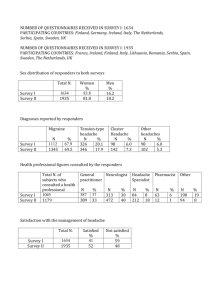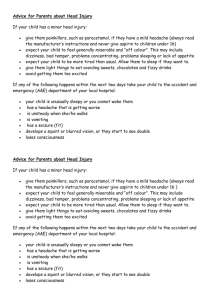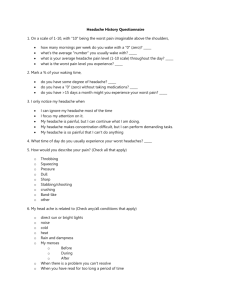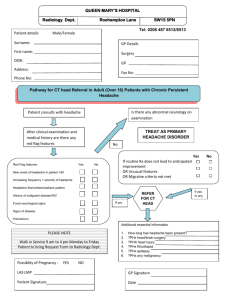Title: Amteropia among children hospitalized for headache
advertisement
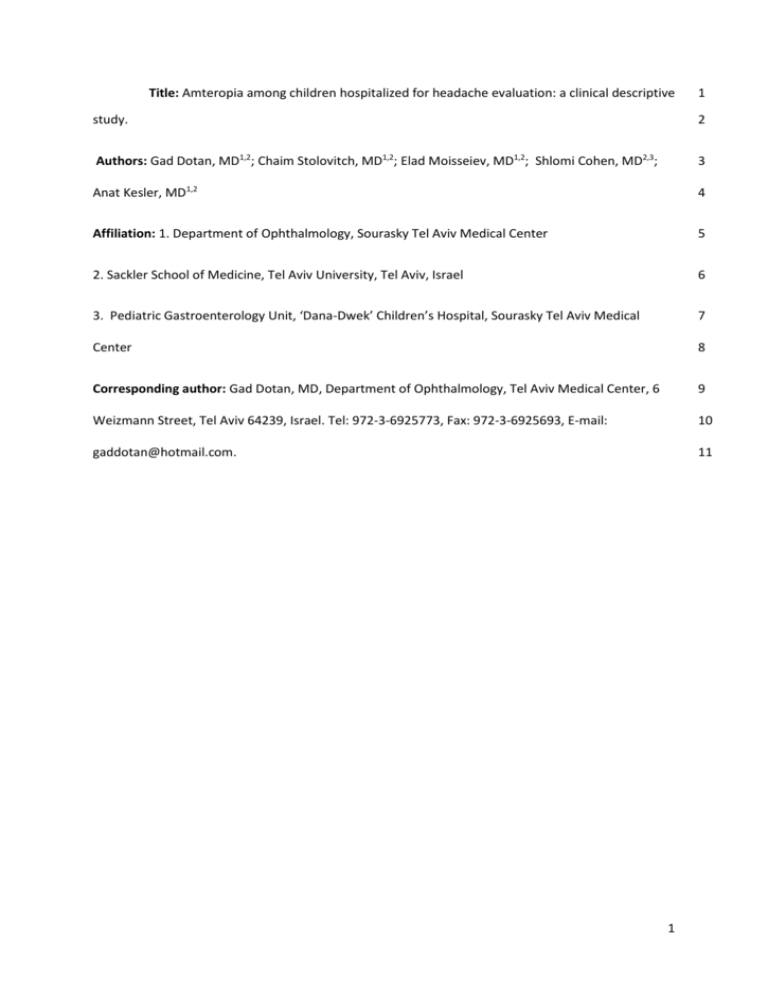
Title: Amteropia among children hospitalized for headache evaluation: a clinical descriptive 1 study. 2 Authors: Gad Dotan, MD1,2; Chaim Stolovitch, MD1,2; Elad Moisseiev, MD1,2; Shlomi Cohen, MD2,3; 3 Anat Kesler, MD1,2 4 Affiliation: 1. Department of Ophthalmology, Sourasky Tel Aviv Medical Center 5 2. Sackler School of Medicine, Tel Aviv University, Tel Aviv, Israel 6 3. Pediatric Gastroenterology Unit, ‘Dana-Dwek’ Children’s Hospital, Sourasky Tel Aviv Medical 7 Center 8 Corresponding author: Gad Dotan, MD, Department of Ophthalmology, Tel Aviv Medical Center, 6 9 Weizmann Street, Tel Aviv 64239, Israel. Tel: 972-3-6925773, Fax: 972-3-6925693, E-mail: 10 gaddotan@hotmail.com. 11 1 Abstract 12 Background: Headache is a common complaint in children occasionally requiring hospital admission. 13 The purposes of the present study were to analyze the prevalence of uncorrected ametropia in 14 children with headache admitted to the hospital, and evaluate the importance of refraction 15 assessment as part of their evaluation. 16 Methods: A retrospective review of children with headache admitted to our medical center for 17 evaluation from December 2008 to March 2013, in whom the only abnormality found was an 18 uncorrected significant refractive error. 19 Results: During the study period 917 children with headache were hospitalized for evaluation and 16 20 (1.7%) of them (9 boys, mean age 12 years, range 8-18 years) were found to have an uncorrected 21 ametropia. Average headache duration was 4 months (range, 1 week to 1 year) and mean follow-up 22 was 15 months (range, 1 month to 3 years). Twelve (75%) children had brain imaging and 4 children 23 (25%) had a lumbar puncture before their refractive abnormality was identified. Anisometropia and 24 myopia were the most common refractive errors encountered (n=10 each), followed by hyperopia 25 (n=6) and astigmatism (n=3). Despite having uncorrected refractive errors most children (n=10) did 26 not complain of any visual difficulty. All children were given proper refractive correction and 14 of 27 them reported on complete headache resolution on re-examination one month later when. 28 Conclusions: Uncorrected ametropia is a possible cause for headache among hospitalized children. 29 Therefore, complete ophthalmic evaluation, which includes proper refraction assessment, is 30 important as it can identify a treatable headache etiology. Children without visual difficulty should 31 be equally evaluated, as many children with headache attributed to amteropia do not report such 32 complaints. 33 Keywords: Headache; Asthenopia; Amteropia; Refractive error 34 2 Background 35 It is well recognized that certain eye conditions such as acute glaucoma, postertior scleritis 36 or optic neuritis may be associated with eye pain and/or headache [1]; however there is much less 37 certainty that uncorrected refractive errors are a possible source for headache. The diagnostic 38 criteria for headache associated with refractive errors defined by the International Headache Society 39 are: 1. Uncorrected or miscorrected refractive errors such as hyperopia or astigmatism, 2. Mild 40 headache in the frontal region and in the eyes themselves, 3. Pain absent on awakening and 41 aggravated by prolonged visual tasks at the distance or angle where vision is impaired. 42 Disappearance of the headache within a month of successful treatment of the underlying disorder is 43 another important diagnostic criterion [2]. 44 Several authors [3- 7] reported on possible association between refractive errors and 45 headache in both children and adults; whereas others [8- 11] reported on the contrary believing that 46 the finding of an abnormal refractive error in an individual with headache is purely coincidental, 47 based on the high prevalence of both conditions in the general population, which does not imply a 48 causal relationship between them. 49 The purposes of the present study were to analyze the prevalence of uncorrected ametropia 50 in children with headache admitted to the hospital, and evaluate the importance of refraction 51 assessment as part of their evaluation. 52 Methods 53 A retrospective analysis was conducted of the medical records of children 8 to 18 years old 54 with headache admitted to our medical center between December 2008 and March 2013 in whom 55 the only abnormality found was uncorrected ametropia. The study was approved by our institutional 56 review board and was fully compliant with the principles of the Declaration of Helsinki. 57 3 None of the children included in this study had any systemic or ocular diseases known to be 58 associated with eye-strain or headache such as glaucoma, optic neuritis or scleritis, or a known 59 refractive error necessitating the use of spectacles or contact lenses. Following a normal 60 neurological examination, which revealed no underlying headache etiology all children underwent a 61 complete ophthalmological evaluation by a pediatric neuro-ophthalmologist (GD) and were asked 62 about difficulty with distance and near visual tasks before examination was initiated. In all children 63 assessment of visual acuity, pupillary reaction, ocular motility, ocular misalignment, slit lamp 64 biomicroscopy, dilated funduscopy and cycloplegic refraction were performed. Visual acuity was 65 measured using a Snellen chart and was converted to the logarithm of the minimum angle of 66 resolution (logMAR) for statistical analysis. Cycloplegic refraction was performed by retinoscopy 67 following administration of two cycles of cyclopentolate 1% in each eye, 5 minute apart. 68 All children included in this study had uncorrected amteropia, which was defined according 69 to the criteria reported by Akinci et al [3]: myopia (spherical equivalent (SE) refraction of at least - 70 0.50 diopters), hyperopia (SE of at least +2.00 diopters), astigmatism (a cylinder of at least 1.00 71 diopters), or anisometropia (SE difference of 1.00 diopters or more between the two eyes). None of 72 the children had any other ophthalmological abnormality known to cause headache, including: 73 convergence or accommodation insufficiency, heterophoria, heterotropia, or peudotumor cerebri. 74 All children were given proper refractive correction and were re-examined one month later. 75 Data were analyzed using Minitab release 14 software (Minitab Inc., State College, PA). 76 Descriptive statistics is provided and for inference testing statistical significance was defined at a 77 level of P<.05. Visual acuity at presentation and at follow-up was compared using a paired t-test. 78 Results 79 During the study period 917 children with headache were hospitalized in our medical center 80 and in 16 (1.7%) of them (9 boys, mean age 12 years; range 8 to 18 years) the only abnormality 81 found was an uncorrected ametropia. Average headache duration was 4 months (range, 1 week to 1 82 4 year) and mean follow-up was 15 months (range, 1 month to 3 years). Twelve (75%) children had a 83 normal brain imaging prior to their ophthalmic examination. Five children had brain computerized 84 tomography, five children had brain magnetic resonance imaging, and two children had both. Four 85 (25%) children had a lumbar puncture as well which demonstrated a normal cerebrospinal fluid 86 opening pressure (16 – 21 cmH20) with normal fluid constituents. 87 Although all 16 children with headache had an uncorrected ametropia (Table 1), 10 of them 88 did not report any visual complaints. Types of refractive errors found were: anisometropia (n=10), 89 myopia (n=10), hyperopia (n=6), and astigmatism (n=3). One month following prescription of optical 90 correction 14 children had complete resolution of headache complaints. Best corrected visual acuity 91 at follow-up (0.01 ± 0.04) was significantly improved compared to presentation (0.25 ± 0.22, 92 P<0.001). 93 Discussion 94 We describe 16 children who had headache requiring hospital admission, in whom the only 95 abnormality found was the presence of uncorrected ametropia. Only a minority of these children 96 had visual complaints as well. Proper refractive correction resulted in resolution of headache 97 complaints in most children. 98 Headache is a frequent pediatric complaint [6]. Hendricks et al [6] reported that 70% of 99 healthy children between the ages of 11 to 13 years had at least one headache episode during a 100 period of 1 year and that 15% of them classified their headache as severe by burden or duration. 101 Although there is a strong popular belief amongst physicians and parents that visual problems can 102 be a cause for headache there is still a controversy in the literature whether such an association truly 103 exists and uncertainty regarding the causal mechanism. Different types of refractive errors have 104 been related to headache complaints. Hyperopia was found to be a possible cause of headache in 105 the studies of Gil-Gouveia et al [4] and Ip et al [7] by causing painful contracture of the ciliary muscle 106 evoked by sustained accommodation. Myopia can lead to headache from squinting of the forehead 107 5 and eyelids in order to narrow the palpebral fissure, achieving a pinhole effect and improving vision 108 [4]. Anisometropia and astigmatism were reported as an etiology of headache in the study of Akinci 109 et al by a mechanism, which is not fully understood, but is probably related to visual blur [3]. In our 110 study the most frequently encountered refractive errors among children with headache related to 111 uncorrected ametropia were anisometropia and myopia (both were present in 63% of children) 112 followed by hyperopia (38% of children) and astigmatism (19% of children). 113 Akinci et al [3] found a high prevalence of uncorrected and miscorrected refractive errors 114 among children 8 to 18 years old with headache in whom an evaluation by a pediatric neurologist, 115 otolaryngologist, and brain imaging did not reveal any pathology; however, they did not report on 116 headache status following optical correction. In our study we have similarly identified 16 children 117 with headache and uncorrected significant refractive errors in whom prior evaluation did not 118 identify headache etiology. Gil-Gouveia et al [4] found that headache was more common in 119 individuals with uncorrected refractive errors compared to matched controls without this refractive 120 abnormality. Seventy three percent of individuals had improvement in their complaints with optical 121 correction, including 38% who had complete headache resolution. In our study we have similarly 122 found that proper optical correction can result in headache elimination. Miscorrection of refractive 123 errors or unnecessary spectacle use can be a source for problem as well. In the study of Robaei et al 124 [5] children wearing glasses without having a significant refractive error in either eye were more 125 likely to have eye-strain or headache complaints compared to all other children. Despite the fact 126 that our study included only children with uncorrected refractive errors, it is clear that children with 127 headache who are wearing glasses or contact lenses should be similarly evaluated for wearing the 128 proper correction. 129 Contrary to the reports mentioned above, other studies found no association between 130 refractive errors and headache. Korczyn et al [8] found no difference in the frequency of headache in 131 individuals with or without refractive errors, Waters [9] reported no difference in the visual acuity of 132 6 individuals with or without headache, and Hedges [10] expressed his disbelief that refractive errors 133 are an important cause for headache. These authors attributed the relief of headache following 134 correction of a refractive error to a placebo treatment effect or a functional etiology. 135 According to Linet et al [12] an ophthalmologist is the third most common practitioner 136 consulted for headache. Ip et al [7] reported that only a minority of 6-years-old children referred for 137 ophthalmological evaluation due to headache or eye-strain complaints had uncorrected refractive 138 errors or an identifiable ocular abnormality and recommended primary care givers to reconsider the 139 need for an ophthalmological evaluation since it is often normal and has a low yield for revealing a 140 treatable eye pathology. Even though we have found uncorrected ametropia in only 1.7% of children 141 admitted to the hospital for headache evaluation we disagree with their conclusion. A complete eye 142 examination, which includes assessment of refraction may identify a treatable cause of headache, 143 reduce anxiety of existence of more serious pathologies and occasionally prevent the need for 144 further investigations. 145 Our study has several limitations, which should be taken into consideration when 146 interpreting its results. First, this was a retrospective record review and is subject to inherent 147 limitation of such a design, mainly the reliance upon the completeness and accuracy of previous 148 medical records. Second, not all children with headache hospitalized during the study period 149 underwent a complete eye examination with refraction assessment; therefore it is possible that the 150 prevalence of amteropia in these children is even higher than reported in this study. Third, we did 151 not routinely complete a headache questionnaire and thus it is impossible for us to better 152 characterize the type of headache complaints of children with uncorrected ametropia. Fourth, our 153 study did not include a control group; therefore we cannot determine whether the prevalence of 154 significant ametropia found in children with headache in different than in children admitted for 155 other reasons. However, despite its limitations our study provides important clinical information as 156 we have found that uncorrected ametropia is a possible etiology of headache in admitted children 157 7 who may not express any visual difficulty, responding to optical treatment. Larger, prospective case- 158 control studies, employing headache questionnaires are still needed to better establish the 159 association of amteropia and headache. 160 Conclusions 161 Uncorrected ametropia is a possible cause for headache among hospitalized children. 162 Therefore, complete ophthalmic evaluation, which includes proper refraction assessment, is 163 important as it can identify a treatable headache etiology. Children without visual difficulty should 164 be equally evaluated, as many children with headache attributed to amteropia do not report such 165 complaints. 166 Competing interests 167 None of the authors have any conflict of interests or a financial or any other interest in the data 168 presented in this study. 169 Authors’ contributions 170 GD conceived this study and was involved in acquisition and interpretation of data, and drafting the 171 manuscript. CS was involved in conception and design of this study and critical revision of the 172 manuscript. EM participated in data acquisition and statistical analysis. SC interpreted the data and 173 revised the manuscript critically for intellectual content. AK was involved in conception and design 174 of this study, and critical revision of the manuscript. All authors read and approved the final 175 manuscript. 176 Acknowledgements 177 None. 178 Ethics 179 8 This study was approved by the Helsinki committee of the Tel Aviv Medical Center, study no. 0559- 180 12-TLV. 181 182 References 183 1. Daroff RB: Ocular causes of headache. Headache 1998, 38:661. 184 2. The International Classification of Headache Disorders: 2nd edition: Headache Classification 185 Subcommittee of the International Headache Society. Cephalalgia 2004, Suppl 1:9-160. 186 3. Akinci A, Güven A, Degerliyurt A, Kibar E, Mutlu M, Citirik M: The correlation between 187 headache and refractive errors. J AAPOS 2008, 12:290-293. 188 4. Gil-Gouveia R, Martins IP: Headaches associated with refractive errors: myth or reality? 189 Headache 2002, 42:256-262. 190 5. Robaei D, Kifley A, Rose KA, Mitchell P: Refractive error and patterns of spectacle use in 12year-old Australian children. Ophthalmology 2006, 113:1567-1573. 191 192 6. Hendricks TJ, DE Brabander J, van Der Horst FG, Hendrikse F, Knottnerus JA: Relationship 193 between habitual refractive errors and headache complaints in schoolchildren. Optom Vis 194 Sci 2007, 84:137-143. 195 7. Ip JM, Robaei D, Rochtchina E, Mitchell P: Prevalence of eye disorders in young children 196 with eyestrain complaints. Am J Ophthalmol 2006, 142:495-497. 197 8. Korczyn AD, Carel RS, Pereg I: Correlation of headache complaints with some physiological 198 parameters in a healthy population. Headache 1980, 20:196-198. 199 9. Waters WE: Headache and the eye. A community study. Lancet 1970, 2:1-4. 200 10. Hedges TR: An ophthalmologist's view of headache. Headache 1979, 19:151-155. 201 11. Cameron ME: Headaches in relation to the eyes. Med J Aust 1976, 1:292-294. 202 12. Linet MS, Stewart WF, Celentano DD, Ziegler D, Sprecher M: An epidemiologic study of 203 headache among adolescents and young adults. JAMA 1989, 261:2211-2216. 204 9 Table 1: Refractive errors encountered in children with headache and visual acuities before and after 205 optical correction. 206 Final logMAR RE Final logMAR LE -0.50 - 1.25 X 170 -1.00 – 1.25 X 10 -0.50 – 1.25 X 170 0.6 0.2 0.0 0.0 2 8 F -2.00 - 0.25 X 180 -2.00 - 0.25 X 180 -2.00 - 0.25 X 180 -2.00 - 0.25 X 180 1.0 1.0 0.0 0.0 3 14 M -0.75 -0.50 X 180 -0.75 – 0.50 X 180 -0.75 -0.50 X 180 -0.75 – 0.50 X 180 0.3 0.2 0.0 0.0 4 14 F +3.00 – 0.25 X 180 +2.00 – 0.25 X 180 +1.50 – 0.25 X 180 +0.50 – 0.25 X 180 0.2 0.0 0.1 0.0 5 17 F 0.00 -3.50 X 130 +0.25 0.00 -3.50 X 130 +0.25 0.3 0.0 0.0 0.0 6 8 M -1.50 -1.75 -1.50 -1.75 1.0 0.7 0.0 0.0 7 13 M +1.50 – 2.00 X 180 +2.00 – 2.25 X 170 0.00 – 2.00 X 180 +0.50 – 2.25 X 170 0.3 0.3 0.0 0.0 8 9 M -1.00 -1.00 -1.00 -1.00 0.2 0.2 0.0 0.0 9 15 F +4.00 – 0.75 X 180 +2.25 -0.25 X 180 +2.50 -0.75 X 180 +0.75 -0.25 X 180 0.3 0.0 0.1 0.0 10 8 M -1.00 – 0.75 X 90 -0.25 – 0.50 X 90 -1.00 – 0.75 X 90 -0.25 – 0.50 X 90 0.1 0.1 0.0 0.0 11 13 M -1.00 – 0.25 X 90 -1.25 – 0.25 X 90 -1.00 – 0.25 X 90 -1.25 – 0.25 X 90 0.2 0.4 0.0 0.0 12 9 M +0.50 +2.75 0.00 +2.25 0.1 0.3 0.0 0.2 13 8 F +0.25 +3.50 – 0.50 X 180 0.00 +3.25 – 0.25 X 180 0.0 0.4 0.0 0.0 14 12 F +1.25 +2.50 0.00 +1.25 0.0 0.0 0.0 0.0 15 10 F -2.00 -1.00 -2.00 -1.00 0.4 0.2 0.0 0.0 16 12 M +3.50 – 0.25 X 180 +4.75 – 0.50 X 180 +2.00 – 0.25 X 180 +3.25 – 0.50 X 180 0.2 0.3 0.0 0.1 Patient (diopters) Initial logMAR LE Initial logMAR RE Glasses prescribed LE Glassed prescribed RE Cycloplegic refraction LE Cycloplegic refraction RE -1.00 - 1.25 X 10 (diopters) M Gender 8 Age (years) 1 13. 207 14. RE = Right eye, LE = Left eye 208 10

